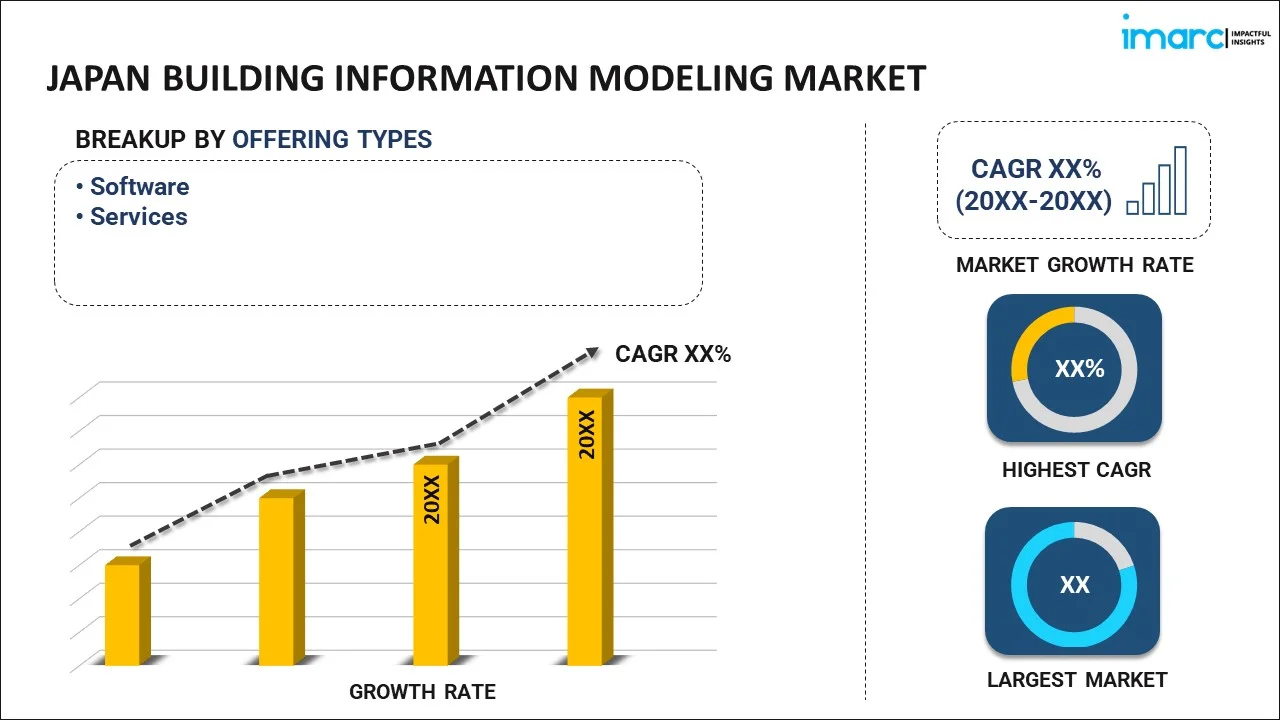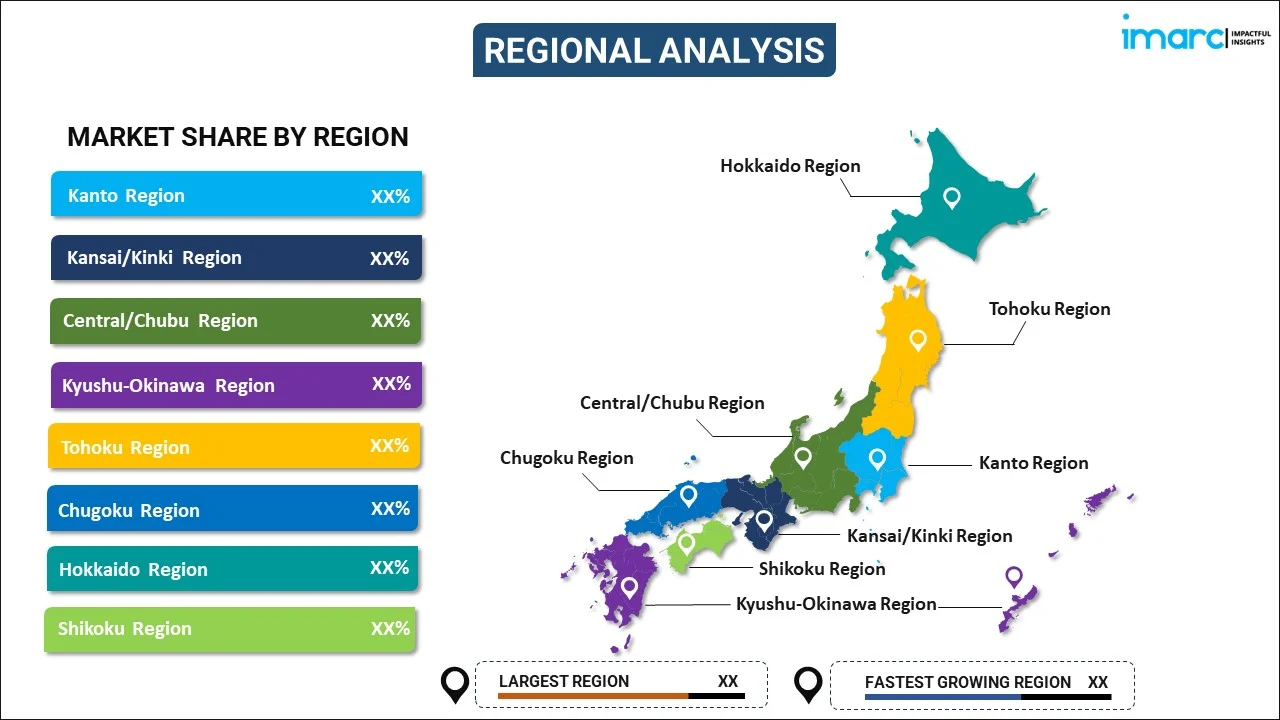
Japan Building Information Modeling Market Report by Offering Type (Software, Services), Deployment Mode (On-premises, Cloud-based), Application (Preconstruction, Construction, Operations), End Use Sector (Commercial, Residential, Industrial), End User (Architects and Engineers, Contractors and Developers, and Others), and Region 2026-2034
Market Overview:
Japan building information modeling market size reached USD 782.2 Million in 2025. Looking forward, IMARC Group expects the market to reach USD 2,635.3 Million by 2034, exhibiting a growth rate (CAGR) of 14.45% during 2026-2034. The growing use of 3D modeling and visualization tools that are integral to construction and architectural processes, rising need for enhanced project visualization and communication, and increasing adoption of sustainable and environment friendly construction practices represent some of the key factors driving the market.
|
Report Attribute
|
Key Statistics
|
|---|---|
|
Base Year
|
2025 |
|
Forecast Years
|
2026-2034 |
|
Historical Years
|
2020-2025
|
| Market Size in 2025 | USD 782.2 Million |
| Market Forecast in 2034 | USD 2,635.3 Million |
| Market Growth Rate (2026-2034) | 14.45% |
Access the full market insights report Request Sample
Building information modeling (BIM) is a sophisticated and comprehensive digital representation of the physical and functional characteristics of a building. It includes 3D geometric representations of building components, including walls, floors, and mechanical systems. It also stores a vast amount of data related to each building component, including materials, cost, dimensions, and maintenance requirements. BIM can be used to develop construction schedules, simulate project sequencing, and track progress over time. It promotes collaboration by enabling real-time sharing and editing of the model among various project stakeholders. It streamlines workflows, reduces errors, and minimizes rework, leading to increased efficiency and cost savings. BIM maintains communication between architects, engineers, contractors, and owners, promoting better decision-making. It allows for testing and validating designs before construction, reducing the likelihood of design flaws. BIM supports the entire building lifecycle, ranging from design and construction to facility management and renovation. It helps identify cost-effective design and construction options, reducing unexpected expenses. It also facilitates higher precision in design and construction, which results in better-quality buildings. It helps identify potential risks and develop mitigation strategies. It can also help ensure that a building complies with local building codes and regulations.
Japan Building Information Modeling Market Trends:
At present, the increasing adoption of 3D modeling and visualization tools, which are becoming integral to the construction and architectural processes, represents one of the crucial factors impelling the growth of the market in Japan. Besides this, the rising need for enhanced project visualization and communication, improved decision-making, and the ability to detect and resolve issues early in the design and construction phases is contributing to the market growth. In addition, the growing adoption of sustainable and environment friendly construction practices is stimulating the integration of BIM with sustainability analysis tools, thereby promoting eco-friendly construction methods and materials. The rising importance of collaboration and information sharing in the BIM ecosystem, driven by the need to improve project efficiency, reduce errors, and enhance communication and coordination among project participants, ultimately leading to better project outcomes, is supporting the market growth in the country. Apart from this, emerging technologies, such as virtual reality (VR), augmented reality (AR), and the Internet of Things (IoT), are utilized to enhance the visualization of construction projects, support maintenance and facility management, and monitor real-time data from buildings and infrastructure. This trend is driven by the desire to create more immersive and interactive experiences in the construction and operation phases and to leverage data for predictive maintenance and smart building management. Furthermore, the increasing popularity of cloud-based BIM solutions, which enable users to access BIM data and models from anywhere, promoting remote collaboration and flexibility in project management, is bolstering the growth of the market in the country.
Japan Building Information Modeling Market Segmentation:
IMARC Group provides an analysis of the key trends in each segment of the market, along with forecasts at the country level for 2026-2034. Our report has categorized the market based on offering type, deployment mode, application, end use sector, and end user.
Offering Type Insights:

To get detailed segment analysis of this market Request Sample
- Software
- Services
The report has provided a detailed breakup and analysis of the market based on the offering type. This includes software and services.
Deployment Mode Insights:
- On-premises
- Cloud-based
A detailed breakup and analysis of the market based on the deployment mode have also been provided in the report. This includes on-premises and cloud-based.
Application Insights:
- Preconstruction
- Construction
- Operations
The report has provided a detailed breakup and analysis of the market based on the application. This includes preconstruction, construction, and operations.
End Use Sector Insights:
- Commercial
- Residential
- Industrial
A detailed breakup and analysis of the market based on the end use sector have also been provided in the report. This includes commercial, residential, and industrial.
End User Insights:
- Architects and Engineers
- Contractors and Developers
- Others
The report has provided a detailed breakup and analysis of the market based on the end user. This includes architects and engineers, contractors and developers, and others.
Regional Insights:

To get detailed regional analysis of this market Request Sample
- Kanto Region
- Kansai/Kinki Region
- Central/ Chubu Region
- Kyushu-Okinawa Region
- Tohoku Region
- Chugoku Region
- Hokkaido Region
- Shikoku Region
The report has also provided a comprehensive analysis of all the major regional markets, which include Kanto Region, Kansai/Kinki Region, Central/ Chubu Region, Kyushu-Okinawa Region, Tohoku Region, Chugoku Region, Hokkaido Region, and Shikoku Region.
Competitive Landscape:
The market research report has also provided a comprehensive analysis of the competitive landscape. Competitive analysis such as market structure, key player positioning, top winning strategies, competitive dashboard, and company evaluation quadrant has been covered in the report. Also, detailed profiles of all major companies have been provided.
Latest News and Developments:
- In May 2025, Daiwa House Industry Co., Ltd. announced the launch of full-scale BIM (Building Information Modeling) support for designing wooden commercial and business facilities starting on June 2, 2025. This initiative aims to promote decarbonization and improve the efficiency of designing wooden structures, supporting Japan's goal of carbon neutrality by 2050. The BIM tools will streamline the design process and enable detailed construction simulations and material estimations for wooden buildings.
Japan Building Information Modeling Market Report Coverage:
| Report Features | Details |
|---|---|
| Base Year of the Analysis | 2025 |
| Historical Period | 2020-2025 |
| Forecast Period | 2026-2034 |
| Units | Million USD |
| Scope of the Report | Exploration of Historical and Forecast Trends, Industry Catalysts and Challenges, Segment-Wise Historical and Predictive Market Assessment:
|
| Offering Types Covered | Software, Services |
| Deployment Modes Covered | On-premises, Cloud-based |
| Applications Covered | Preconstruction, Construction, Operations |
| End Use Sectors Covered | Commercial, Residential, Industrial |
| End Users Covered | Architects and Engineers, Contractors and Developers, Others |
| Regions Covered | Kanto Region, Kansai/Kinki Region, Central/ Chubu Region, Kyushu-Okinawa Region, Tohoku Region, Chugoku Region, Hokkaido Region, Shikoku Region |
| Customization Scope | 10% Free Customization |
| Post-Sale Analyst Support | 10-12 Weeks |
| Delivery Format | PDF and Excel through Email (We can also provide the editable version of the report in PPT/Word format on special request) |
Key Benefits for Stakeholders:
- IMARC’s industry report offers a comprehensive quantitative analysis of various market segments, historical and current market trends, market forecasts, and dynamics of the Japan building information modeling market from 2020-2034.
- The research report provides the latest information on the market drivers, challenges, and opportunities in the Japan building information modeling market.
- Porter's five forces analysis assist stakeholders in assessing the impact of new entrants, competitive rivalry, supplier power, buyer power, and the threat of substitution. It helps stakeholders to analyze the level of competition within the Japan building information modeling industry and its attractiveness.
- Competitive landscape allows stakeholders to understand their competitive environment and provides an insight into the current positions of key players in the market.
Key Questions Answered in This Report
The building information modeling market in Japan was valued at USD 782.2 Million in 2025.
The Japan building information modeling market is projected to exhibit a CAGR of 14.45% during 2026-2034, reaching a value of USD 2,635.3 Million by 2034.
The Japan building information modeling market is driven by government initiatives for digital construction, the growing demand for efficient project management, rising urban development, and the need to reduce costs and errors. Adoption is further supported by increased collaboration requirements, technological innovation in design and construction, and industry shift toward sustainable, data-driven building practices.
Need more help?
- Speak to our experienced analysts for insights on the current market scenarios.
- Include additional segments and countries to customize the report as per your requirement.
- Gain an unparalleled competitive advantage in your domain by understanding how to utilize the report and positively impacting your operations and revenue.
- For further assistance, please connect with our analysts.
 Request Customization
Request Customization
 Speak to an Analyst
Speak to an Analyst
 Request Brochure
Request Brochure
 Inquire Before Buying
Inquire Before Buying




.webp)




.webp)












